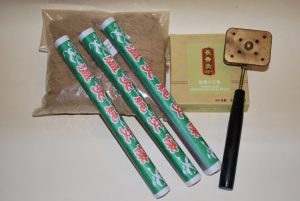Where There’s Smoke, There’s Moxibustion

In the ancient Chinese book Ling Shu, chapter Guen Neng, it says that “when the needle does not work; moxibustion will.”
So, what is moxibustion?
Moxibustion (Pinyin jiu) involves the burning of moxa, or the herb Mugwort (Artemisia vulgaris), which is applied to certain acupuncture points on the body. It has been part of traditional Chinese medicine for so long that no one is really sure when it first began. Although, the first written discussion of moxibustion appeared in the pre-Qin dynasty of China, 581 BC.
“Moxibustion is described as using fire to warm the yang and to eliminate the cold of yin. It can melt the poisoning things caused by damp wind, phlegm, blood stasis, and etc. Fire can drain the channels, remove the pain and numbness, and activate the blood and chi.” ~ Dr. Barbara Fougere, BVSc, DVM
Moxibustion can be used for disease prevention and health maintenance. Also, for pain relief, improve circulation, an immune system boost, enhances vitality, reduces blood flow to tumors, etc. And, it has a good effect on skin lesions, like, verruca, leishmania, herpes, cutaneous necrosis, and poor wound healing. Various acupuncture points that are stimulated by moxa have an internal visceral effect…right down to the organs. For example, moxa on acupoints BL40/BL41 helps incontinence; LV14 protects the liver. And, the good news is you only need to learn a small number of acupuncture points to perform it successfully. So, no one should feel intimidated by using moxibustion on yourself or others, including your pets.
However, there are 28 acupoints to avoid when using moxibustion. This would include points on the face, sense organs (nose & eyes), or regions with large blood vessels. Also, avoid moxa on the abdomen and lumbosacral during pregnancy.
What is the evidence of success?
In 1998, a study done by the Journal of American Medical Association showed that the effects of moxibustion had turned 75% breeched babies to a normal birth position. In a 2013 study, moxibustion showed a reduced need for the pain-killer oxytocin after child birth.

In a 2015 study on rats that had precancerous lesions of atropic gastritis were treated with moxibustion “at the stomach meridian acupoints or control points for 30 minutes a day” had shown to inhibit dysplasia and promoted the recovery of the gastric mucosa after it has been damaged (Read Study).
In 2018, moxibustion was shown to help modulate the gut microbiota and immune fuction in cases of ulcerative colitis (see Study).
In 2020, animal studies demonstrated that moxibustion plays an important role in anti-inflammatory and pain relief, especially for the treatment of musculoskeletal diseases, such as, primary osteoporosis, cervical spondylosis, and knee osteoarthritis. Studies found that the therapeutic effects of moxibustion seem to be related to anti-inflammatory and immune regulation. In recent years, a large number of studies, especially animal experiment studies, have illustrated the anti-inflammatory effects of moxibustion for rheumatoid arthriris (see Study).
How do you use Moxibustion?
Moxa comes either loose or rolled into 6 to 10-inch-long cigar-shape sticks. There are two methods: Direct and indirect. A direct method is where the loose moxa is rolled into small cones and burned like an incense on the skin (an indirect version is where the cone is placed on a thin slice of ginger, so you don’t touch and burn the skin).
NOTE: I don’t recommend the cones for animals. If you use loose Moxa, the herb should be burned inside a brass or wood container and then slowly rolled over, or placed, on an acupoint. When using the brass/wood container, a cloth must be placed between the container and skin or it’ll get too hot and can cause a burn.
For animals, indirect methods are best. Or, better yet, the Suspending Method where you hold a burning moxa stick above the acupoint. I like to use the smokeless moxa sticks, especially with animals. Moxa sticks are usually smokey and have a strong herbal scent (moxa smells like marijuana). However, high quality moxa will be less smelly and less smokey.
To know whether you’re buying high quality moxa it’s important that it is pale yellow in color. If it’s greenish then it’s poor quality. Also, the moxa should be aged for at least a year. It should be dry and fluffy, ignite easily, leave a little ash, and the heat will be soft and pleasant.
My Siamese cat, Poppy, enjoys moxibustion. She’ll sit on my lap while I use a moxa stick on acupoints ST36, BL23, and GV4. I guess she enjoys the heat treatment. But more importantly, these three points are often mentioned in Chinese ancient literature as a way to slow aging and encourage good health.
Further reading:
The Mechanism of Moxibustion: Ancient Theory and Modern Research










